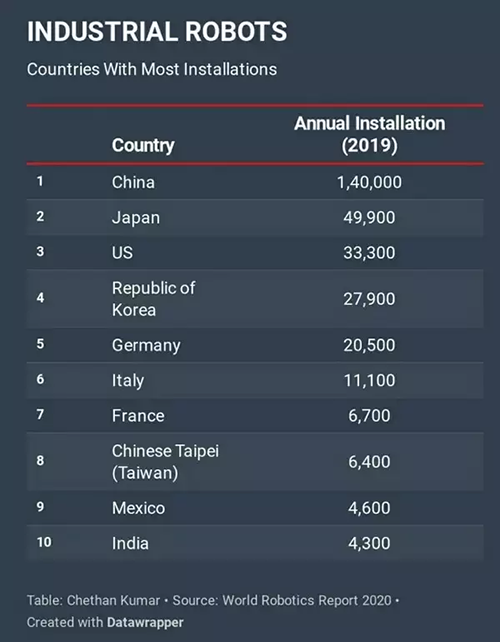
Are ChatGPT & IFR Like Minded?
Indian Robotics: Sometimes the Future Is Now
Is India next up for an automation makeover? It appears so, and Indian robotics is rolling out to the launchpad to drive it all.
The International Federation of Robotics (IFR) is finally high on Indian robotics. Even ChatGPT is aboard, exclaiming with conviction that India could become a robotics powerhouse (see below for ChatGPT’s take on “Bhārat”)
Is Indian robotics getting big, impressive, and exciting?
When the director of the Asia and Pacific Department of the International Monetary Fund (IMF) says (2 May 2023), Asia, predominantly driven by the buoyant outlook for China and India, will be the most dynamic of the world’s major regions in 2023, it’s refreshing to hear the name India as being a major part of the success equation.
The most populous country in the world (1.4 billion) has been long overlooked for most anything in robotics technology, but that appears to be changing fast.
Then there’s Sonam Motwani, founder and CEO of Karkhana.io, an on-demand, B2B manufacturing platform, predicting: “As India gears up for Industry 4.0, demand is going to pour in, and we will see several trends in digitization in the manufacturing industry; the manufacturing sector, contributing to over 14.5% of the country’s GDP, is expected to create 100 million new jobs and touch the $1 trillion mark by 2025”
It’s now patently clear after a near decade of building out new-age manufacturing that the key to automation for Industry 4.0 is robotics. Industrial arms large and small, cobots, AMRs, AGVs, AS/RS, and service robots…on land, sea, and air are the building tools for any future at almost anything. Is India next up for an automation makeover? It appears so, and Indian robotics is rolling out to the launchpad to drive it all.
The timing couldn’t be better for India. Especially noteworthy comes the recent report from the International Federation of Robotics (IFR) about India’s “robot boom”. The IFR’s India´s Robot Boom Hits All-Time High recounts a very significant turnaround from the paltry numbers of industrial robots India has purchased and deployed in the past.
And lo and behold, India has finally inched its way to #10 on the Top 10 list of countries with the most deployed industrial robots.

Combine that with the country’s drastically increased Foreign Direct Investment (FDI), plus more foreign manufacturers moving production to India,
a burgeoning tech startup ecosystem, and real money (although only $6.4 billion) for Industry 4.0, one could realistically say that India is on the launch pad to something big, impressive, and exciting.

For example, the five friends who launched AMR maker Addverb Technologies in Delhi in 2016 seem to think so. They created Addverb not only for themselves as a business but also for their homeland as a symbol of what can be accomplished. They hope to “encourage creativity and foster collaboration among the top technopreneurs in the nation…Addverb hopes to develop a self-sufficient robotics sector in India and export cutting-edge goods and game-changing technological solutions to the rest of the world.” Their message: follow our example.
See also: The Importance of [Ro]Bot-Valley (Noida) to the Future Of Indian Technology [especially robotics].
In May (2023), the International Federation of Robotics (IFR) released a report that displayed the most optimistic outlook for Indian robotics that we’ve seen in recent memory. Asian Robotics Review has been publishing its special column on Indian robotics called Don’t Forget India since 2017, and this IFR release is the most bullish we’ve seen yet: India´s Robot Boom Hits All-Time High. The title alone conveys the new acceptance of India as a serious and important tech producer of robotics excellence.
We thought the IFR release and the ChatGPT commentary significant enough to reprint both here in their entirety.

We asked ChatGPT: Does India have a chance at becoming a robotics powerhouse?
Yes, India certainly has the potential to become a robotics powerhouse. India is already making significant strides in the field of robotics, and the Indian government has recognized the potential of robotics in driving economic growth and technological innovation.
India has a large pool of engineering talent and a thriving startup ecosystem that is focused on developing cutting-edge technologies. The Indian government has also launched several initiatives to promote the development and adoption of robotics in various sectors such as healthcare, defense, and manufacturing.
Additionally, India has a vast and growing market for robotics, with the country being one of the largest consumers of industrial robots. This creates a favorable environment for the growth of the robotics industry in India, as companies can develop and test their technologies in a local market before scaling up globally.
However, there are also challenges that India must overcome to become a robotics powerhouse. One of the main challenges is the lack of a robust supply chain for robotics components, which makes it difficult for companies to manufacture and develop high-quality robotics products. Additionally, there is a shortage of skilled workers who can design, build, and maintain robots, which is crucial for the growth of the industry.
Overall, India has a good chance of becoming a robotics powerhouse if it can overcome these challenges and continue to invest in research and development, promote innovation, and create a favorable business environment for robotics companies.
IFR: India´s Robot Boom Hits All-Time High
Frankfurt, May 03, 2023
India enters world´s top ten in annual robot installations.
Sales of industrial robots in India reached a new record of 4,945 units installed. This is an increase of 54 percent compared to the previous year (2020: 3,215 units). In terms of annual installations, India now ranks in tenth position worldwide. These are findings of the report World Robotics, presented by the International Federation of Robotics (IFR).
“India is one of the world’s fastest-growing industrial economies,” says Marina Bill, President of the International Federation of Robotics. “Within five years, the operational stock of industrial robots has more than doubled, to reach 33,220 units in 2021. This corresponds to an average annual growth rate of 16% since 2016.”
Today, India is the world’s fifth-largest economy measured by manufacturing output. According to World Bank data, India´s manufacturing value added in 2021 was USD 443.9 billion, a 21.6% increase from 2020.
The automotive industry remains the largest customer for the robotics industry in India with a share of 31% in 2021. Installations more than doubled to 1,547 units (+108%). The general industry in India is led by the metal industry with 308 units (-9%), the rubber and plastics industry with 246 units (+27%), and the electrical/electronics industry with 215 units (+98%).
Impressive potential for India
The long-term potential of robotics in India becomes clearer when compared to China: India´s robot density in the automotive industry, which is the number of industrial robots per 10,000 employees, reached 148 robots in 2021. China´s robot density hit 131 units in 2010 and skyrocketed to 772 units in 2021.
The Indian government supports growth in the industrial sector as one of the vital figures that affect the Gross Domestic Product (GDP). Today, the country´s GDP of about $3 trillion ranks in fifth place, head-to-head with the UK and France – behind Germany, Japan, China, and the USA – the International Monetary Fund reports.
Outlook for India
“As a result of the recent supply chain disruption, companies are rethinking their nearshoring strategies in Southeast Asia,” says Marina Bill. “India has traditionally been a popular destination for nearshoring in the manufacturing segment. The Indian government wants the country to be considered for new diversification options such as friend shoring, which is partnering with countries that share similar values and interests.”
The manufacturing sector is also expected to benefit from the government’s initiatives to boost its competitiveness and attractiveness for investors. The Production Linked Incentive (PLI) scheme, for example, currently set to run until 2025, subsidizes companies that create production capacity in India in robot customer industries like automotive, metal, pharmaceuticals, and food processing.
Robots help to create new jobs
New manufacturing capacities in India are an important step to provide adequate education and employment opportunities for its people: According to projections of the United Nations, India now has a population of 1,4 billion, surpassing China for the first time. This means that India has a large and young workforce that can drive economic growth and innovation. India is expected to have the largest working-age population in the world by 2027.

